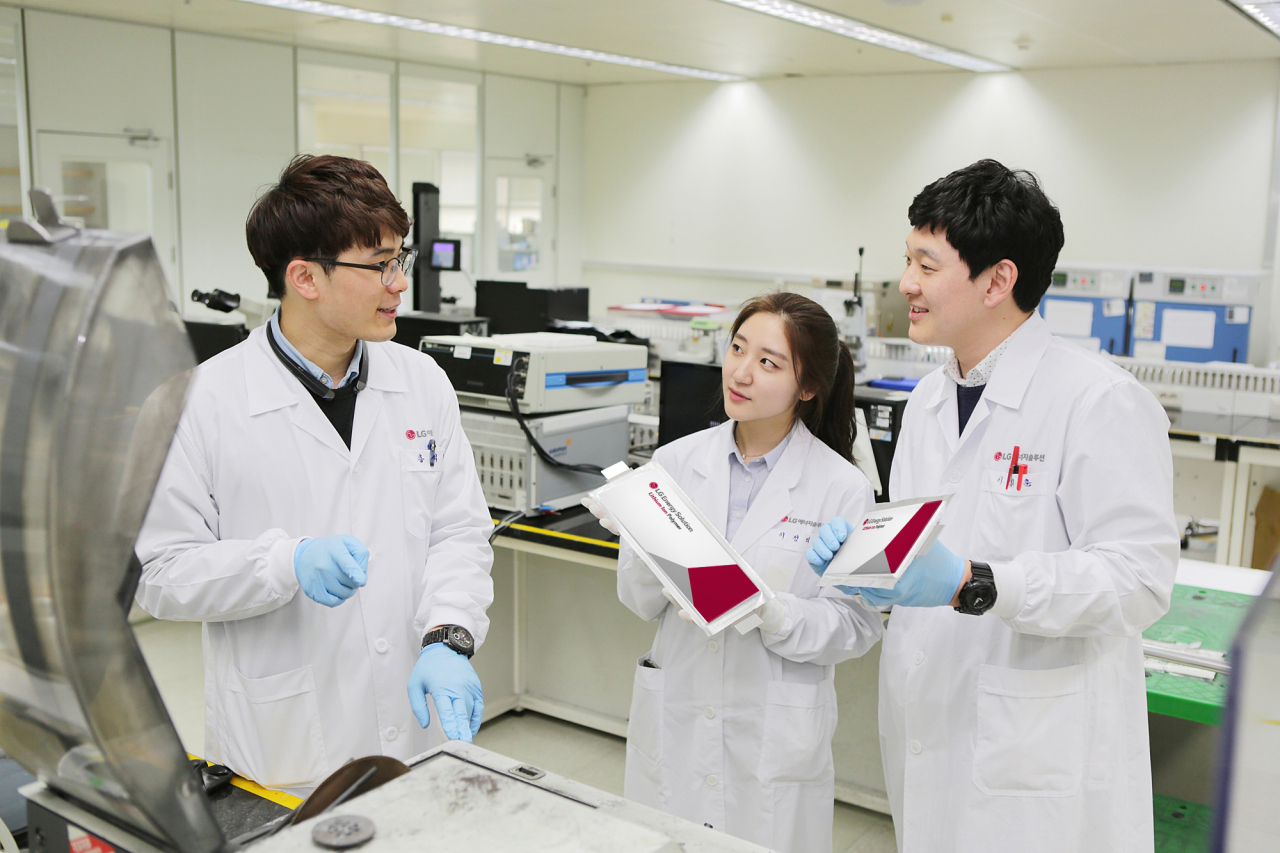
LG Energy Solution officials hold pouch-type batteries at the company’s research facility in Daejeon. (LG Energy Solution)
LG Energy Solution is widening a “super gap” with its competition based on know-hows accumulated throughout 30 years of battery business.
According to South Korea’s leading battery firm, it poured more than 5.3 billion won ($4.6 billion) into research and development over the past decade and secured 23,610 battery patents as a result, which is at least 10 times as many as that of a leading Chinese battery player as of last year.
Equipped with more than 2,500 R&D personnel, LG Energy Solution in 2007 became the world’s first to mass-produce NCM523 lithium-ion batteries. In 2016, it was also the world’s first to mass-produce NCM622 batteries, according to the company. NCM refers to the metals used in the batteries -- nickel, cobalt and manganese. The three digits that follow represent the ratio of each of the metals used inside cathodes.
Cathodes are one of the four key components of lithium-ion batteries along with anodes, electrolytes and separators. The more nickel inside cathodes, the more powerful batteries become. Simply put, cathodes decide batteries’ power.
To take things up a notch, LG Energy Solution will mass-produce NCMA batteries in the second half of this year by adding aluminum to NCM batteries.
The NCMA batteries -- which will contain 90 percent nickel, 5 percent cobalt and the rest manganese and aluminum -- are capable of rapid charging and exhibit key advantages compared to NCM chemistry batteries including higher energy density, longer lifespan and greater fire resistance.
LG Energy Solution’s technological advancement extends to anodes. In 2019, the company added silicon to anodes and became the world’s first to mass-produce batteries capable of rapid charging up to 80 percent within 20 minutes. In the same year, the company supplied the silicon anode batteries to premium European automakers.
Anodes, which mostly contain graphite, account for batteries’ stability. Adding a small amount of silicon inside anodes can enhance batteries’ performance significantly because a single silicon atom can accommodate four lithium ions whereas it takes six atoms of graphite to manage one lithium ion.
On top of unparalleled cathode and anode technologies, LG Energy Solution has propelled innovations in the battery structure.
Inside typical batteries, a thin film of three layers -- in the sequence of cathode, separator and anode -- is rolled up like toilet paper. However, the roll has round edges, leaving leftover spaces inside batteries, which translates into loss of energy density.
Instead of rolling, LG Energy Solution stacks battery components together to minimize wasted space. The company’s patented Lamination & Stacking technology cuts sheets of cathodes, separators and anodes in the matching size and shape of batteries’ containers and then stacks these sheets one after another. As a result, Lamination & Stacking technology enhances batteries’ energy density and structural integrity.
Also, LG Energy Solution developed safety reinforced separator or SRS technology in 2004. Separators are basically thin elastic walls with tiny holes that divide cathodes from anodes. When batteries are charged and discharged, ions go back and forth between cathodes and anodes through these tiny holes. Separators prevent cathodes and anodes from reacting to each other and triggering short circuits or fires. In short, separators are what prevent batteries from exploding.
The SRS technology coats separators with ceramic materials, making them more durable to internal and external shocks. LG Energy Solution holds about 800 patents regarding the SRS technology in Korea, China, Japan, China and the US. The company has received more than 100 billion won in license fees from the SRS technology.
“Batteries, which require complicated raw materials technologies and mix compositions, can’t be reverse engineered. Simply put, batteries can’t be copied even if they taken apart. For this reason, LG Energy Solution protects core technologies as trade secrets and patents other major technologies,” a company official said.
LG Energy Solution also puts a strong emphasis on production capabilities, as it stands as the world’s only battery company to have production facilities in Korea, China, Europe and the US -- one in Ochang, Korea, two in Nanjing, China, one in Wroclaw, Poland, and one in Michigan, the US. LG Energy Solution is building another battery factory with General Motors in Ohio set for completion in the next two years. Combined, the factories can manufacture batteries for 2 million electric vehicles per year.
By Kim Byung-wook (khnews@heraldcorp.com)





![[Weekender] How DDP emerged as an icon of Seoul](http://res.heraldm.com/phpwas/restmb_idxmake.php?idx=645&simg=/content/image/2024/04/25/20240425050915_0.jpg&u=)
